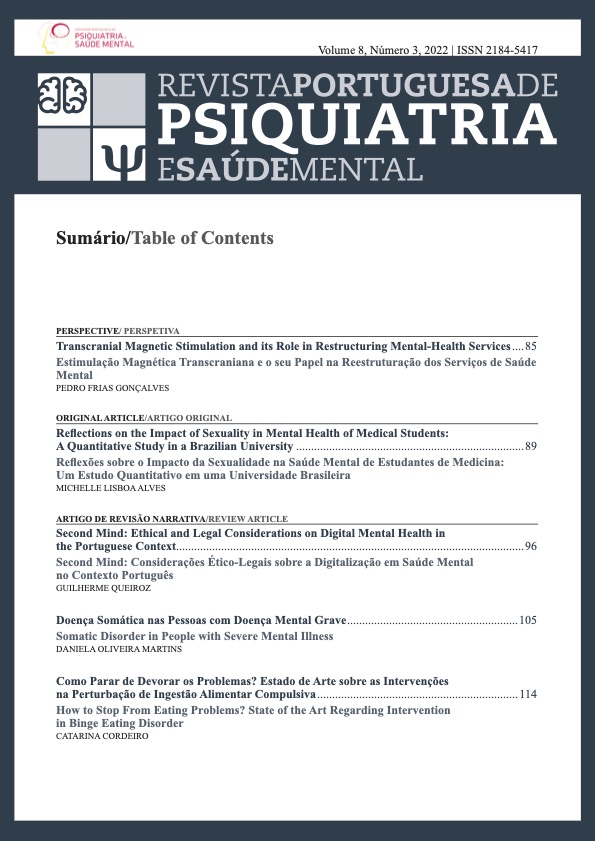Cotard’s Syndrome: A Rare Clinical Case
DOI:
https://doi.org/10.51338/rppsm.346Keywords:
Delusions, Electroconvulsive Therapy, Psychotic Disorders/drug therapy, Psychotic Disorders/therapyAbstract
Cotard’s syndrome is a rare neuropsychiatric condition. It is a syndrome characterized by the presence of mood‐congruent nihilistic delusions. The aim of the present paper is to review literature evidence concerning Cotard’s syndrome and to describe a clinical case. Data were obtained from clinical records and bibliographic research on PubMed.
We present the case of a 68‐year‐old woman with Cotard’s syndrome, in the context of a depressive disorder, to illustrate both how impairing the condition can be and how a course of effective, individualized therapy can improve outcome. Re‐ garding treatment, the combination of antipsychotics and antidepressants is often used, but if this shows no improvement, electroconvulsive therapy is suggested.
There is a need for greater awareness of this syndrome, to ensure better and faster identification and treatment of patients.
Downloads
References
Machado L, Peregrino A, Azoubel S, Cerqueira H, Lima L. Cotard’s syndrome and major depression with psychotic symptoms. Rev Bras Psiquiatr. 2013; 35:212.
Gramary A, Romero J.M, Venâncio A, Moreira M, Oliveira M. Delírio de Negação de Cotard. Acta Med Port. 2004; 17: 106‐108.
Sousa L, Oliveira S, Bastos L. Revisitando a Síndrome de Cotard: Ilustração de Dois Casos Clínicos Psi‐ quiátricos. Psilogos, 2015;13:67‐77.
Grover S, Aneja J, Mahajan S, Varma S. Cotard’s syndrome: Two case reports and a brief review of literature. J Neurosci Rural Pract. 2014;5:S59‐62. doi: 10.4103/0976‐3147.145206.
Wani ZA, Khan AW, Baba AA, Khan HA, Wani QU, Taploo R. Cotard’s syndrome and delayed diagnosis in Kashmir, India. Int J Ment Health Syst. 2008;2:1. doi: 10.1186/1752‐4458‐2‐1.
Basu A, Singh P, Gupta R, Soni S. Cotard syndrome with catatonia: unique combination. Indian J Psychol Med. 2013;35:314‐6. doi: 10.4103/0253‐7176.119490.
Gul S, Khan U, Younus S. I’m dead, the reality of walking corpse syndrome (Cotard’Tomasetti syn‐ drome). Int J Pharmac Therap. 2015; 6219‐23.
Debruyne H, Portzky M, Eynde F, Audenaert K. Co‐ tard’s Syndrome: A Review. Curr Psychiatry Rep. 2009; 11:197‐202.
Mughal F, Menezes S. Severe depression with Co‐ tard’s phenomenon: treatment of a capacitated patient within the United Kingdom’s Mental Health Act 2007. Ment Illn. 2013; 5:e3.
Po-Han C, BenTang L, TsuoHung L, ChinHong C. Chronic Cotard’s syndrome: Recovery from 2 years’ bed‐ridden status. Psychiatry Clin Neurosci. 2011; 65:301.
Machado L, Filho L, Machado L. When the Patient Believes that the organs are destroyed: Manifestation of Cotard’s Syndrome. Case Rep Med. 2016: 5101357.
Berrios G, Luque R. Cotard’s Syndrome: Analysis of 100 cases. Acta Psychiatr Scand. 1995: 91: 185‐8.
Hans D, Kurt A. Towards understanding Cotard’s syndrome: An overview. Neuropsychiatry. 2012;2:481‐6.
Tomasetti C, Valchera A, Fornaro M, Vellante F, Orsolini L, Carano A et al. The ‘dead man walking’ disorder: an update on Cotard’s syndrome. Int Rev Psychiatry. 2020; 1369‐627.
Yamada K, Katsuragi S, Fujii I. A case study of Co‐ tard’s syndrome: Stages and Diagnosis. Acta Psychiatr Scand. 1999:100:396‐9.
LuqueR,BerriosG.Cotard’sSyndromeintheelderly: Historical and clinical aspects. Int J Geriatr Psychiatry. 1994;9:957‐64.








